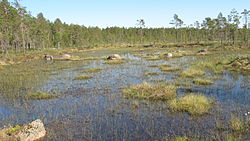




A bog or bogland is a wetland that accumulates peat as a deposit of dead plant materials – often mosses, typically sphagnum moss.[1] It is one of the four main types of wetlands. Other names for bogs include mire, mosses, quagmire, and muskeg; alkaline mires are called fens.[clarification needed] A bayhead is another type of bog found in the forest of the Gulf Coast states in the United States.[2][3] They are often covered in heath or heather shrubs rooted in the sphagnum moss and peat. The gradual accumulation of decayed plant material in a bog functions as a carbon sink.[4][5]
Bogs occur where the water at the ground surface is acidic and low in nutrients. A bog usually is found at a freshwater soft spongy ground that is made up of decayed plant matter which is known as peat. They are generally found in cooler northern climates and are formed in poorly draining lake basins.[6] In contrast to fens, they derive most of their water from precipitation rather than mineral-rich ground or surface water.[7] Water flowing out of bogs has a characteristic brown colour, which comes from dissolved peat tannins. In general, the low fertility and cool climate result in relatively slow plant growth, but decay is even slower due to low oxygen levels in saturated bog soils. Hence, peat accumulates. Large areas of the landscape can be covered many meters deep in peat.[1][8]
Bogs have distinctive assemblages of animal, fungal, and plant species, and are of high importance for biodiversity, particularly in landscapes that are otherwise settled and farmed.
- ^ a b Keddy, P.A. (2010). Wetland Ecology: Principles and Conservation (2nd ed.). Cambridge University Press. ISBN 978-0521739672.
- ^ Watson, Geraldine Ellis (2000) Big Thicket Plant Ecology: An Introduction, Third Edition (Temple Big Thicket Series #5). University of North Texas Press. Denton, Texas. 152 pp. ISBN 978-1574412147
- ^ Texas Parks and Wildlife. Ecological Mapping Systems of Texas: "West Gulf Coastal Plain Seepage Swamp and Baygall". Retrieved 7 July 2020
- ^ Rosenthal, Elisabeth (6 October 2012). "British Soil Is Battlefield Over Peat, for Bogs' Sake". The New York Times. Archived from the original on 7 October 2012. Retrieved 7 October 2012.
- ^ "Peatlands and climate change". IUCN. 6 November 2017. Retrieved 15 August 2019.
- ^ "Bog". Education | National Geographic Society. Retrieved 25 February 2023.
- ^ Rydin, Håkan; Jeglum, J. K. (2013). The Biology of Peatlands (Second ed.). Oxford, UK: Oxford University Press Oxford. ISBN 978-0-19-150828-8. OCLC 861559248.
- ^ Gorham, E. (1957). "The development of peatlands". Quarterly Review of Biology. 32 (2): 145–66. doi:10.1086/401755. S2CID 129085635.